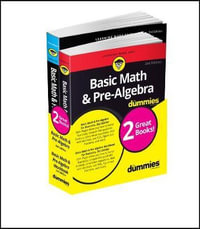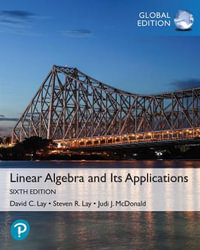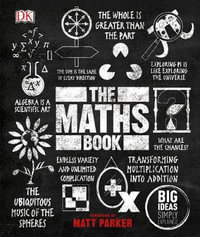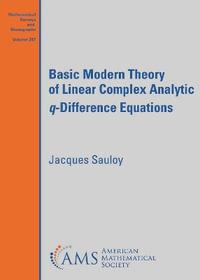Designed for use by first-year graduate students from a variety of engineering and scientific disciplines, this comprehensive textbook covers the solution of linear systems, least squares problems, eigenvalue problems, and the singular value decomposition. The author, who helped design the widely-used LAPACK and ScaLAPACK linear algebra libraries, draws on this experience to present state-of-the-art techniques for these problems, including recommendations of which algorithms to use in a variety of practical situations.
This is the book for you if you are looking for a textbook that:
Teaches state-of-the-art techniques for solving linear algebra problems. Covers the most important methods for dense and sparse problems.Presents both the mathematical background and good software techniques. Is self-contained, assuming only a good undergraduate background in linear algebra.
Algorithms are derived in a mathematically illuminating way, including condition numbers and error bounds. Direct and iterative algorithms, suitable for dense and sparse matrices, are discussed. Algorithm design for modern computer architectures, where moving data is often more expensive than arithmetic operations, is discussed in detail, using LAPACK as an illustration. There are many numerical examples throughout the text and in the problems at the ends of chapters, most of which are written in Matlab and are freely available on the Web.
Material either not available elsewhere, or presented quite differently in other textbooks, includes:A discussion of the impact of modern cache-based computer memories on algorithm design.Frequent recommendations and pointers in the text to the best software currently available, including a detailed performance comparison of state-of-the-art software for eigenvalue and least squares problems, and a description of sparse direct solvers for serial and parallel machines. A discussion of iterative methods ranging from Jacobi's method to multigrid and domain decomposition, with performance comparisons on a model problem.A great deal of Matlab-based software, available on the Web, which either implements algorithms presented in the book, produces the figures in the book, or is used in homework problems.Numerical examples drawn from fields ranging from mechanical vibrations to computational geometry.High-accuracy algorithms for solving linear systems and eigenvalue problems, along with tighter ""relative"" error bounds. Dynamical systems interpretations of some eigenvalue algorithms.
Demmel discusses several current research topics, making students aware of both the lively research taking place and connections to other parts of numerical analysis, mathematics, and computer science. Some of this material is developed in questions at the end of each chapter, which are marked Easy, Medium, or Hard according to their difficulty. Some questions are straightforward, supplying proofs of lemmas used in the text. Others are more difficult theoretical or computing problems. Questions involving significant amounts of programming are marked Programming. The computing questions mainly involve Matlab programming, and others involve retrieving, using, and perhaps modifying LAPACK code from NETLIB.Industry Reviews
'If you do any computing with matrices - including linear systems, least squares, and eigenvalues - this book cannot but help you understand what you are doing and why. It presents state-of-the-art material (as of June 1997) and can serve as a text or a reference...' L. Ehrlich, Randallstown, MD Computing Reviews '...This book is a friendly treatment of numerical linear algebra tailored to first-year graduate students from a variety of engineering and scientific disciplines. The treatment of rounding error analysis and perturbation theory is exceptionally thorough and careful ... The author's writing style is very clear and a pleasure to read.' William W. Hager, Mathematical Reviews '...The disposition is very much like a series of lectures, new concepts are introduced precisely where needed ... Illustrating examples are given, some reporting really heavy computations, but the author does not shy away from giving mathematical proofs where that is needed ...' A. Ruhe, Zeitschrift fur Mathematik und ihre Grenzgebiete '...Compare Demmel with the standard work by G. Golub and C. Van Loan, Matrix Computations (3rd ed., 1996) ... Demmel offers a smaller number of topics but focuses on the most important, and provides a more readable introduction for beginners.' B. Borchers, CHOICE '... highly recommended to graduate students in the field and a must for university libraries. Students will enjoy the gradual introduction to problems clearly marked as Easy, Medium, or Hard according to their level of difficulty. Readers will benefit from reading the preface to acquaint themselves with the philosophy that guided the author while writing the book.' L. Y. Bahar, Applied Mechanics Review "Jim Demmel's book on applied numerical linear algebra is a wonderful text blending together the mathematical basis, good numerical software, and practical knowledge for solving real problems. It is destined to be a classic." -Jack Dongarra, Department of Computer Science, University of Tennessee, Knoxville. "This book has many unprecedented features as a graduate textbook and research reference book on numerical linear algebra and matrix computations. Many topics appear for the first time in a graduate textbook, such as single precision iterative refinement, relative perturbation theory, full-version of divide-and-conquer method, high precision Jacobi method, connection of QR method and the Toda lattice and so on. ...It is astonishing to what extent this book, by means of systematic and easily understandable exposition, has succeeded in making clear the state of the art of numerical linear algebra theory, methods and analysis which we numerical analysts consider the lively frontier of our current work." -Zhaojun Bai, University of Kentucky. "This is an excellent graduate-level textbook for people who want to learn or teach the state of the art of numerical linear algebra. It covers systematically all the fundamental topics in theory, as well as software implementation. The book is very easy to use in the classroom since it provides pointers, in the book and on the author's home page, to lots of available Matlab and LAPACK routines, and it has a large number of homework problems marked with Easy, Medium and Hard. The book requires the students to have a stronger background in linear algebra than most other engineering books on numerical linear algebra." -Xia-Chuan Cai, Department of Computer Science, University of Colorado. "Demmel's book covers the state of the art tools of numerical linear algebra. He tells us how they work and why they work so well. He also gives many references to recent research work. ... he avoids including everything, so the book is still easy to read. ..." -Martin H. Gutknecht, IPS Supercomputing in Zurich, Switzerland.
























